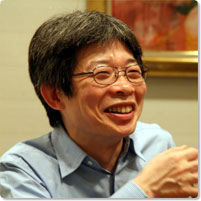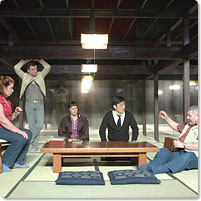Premiere: 2007
Length: 1 hr. 30 min.
Acts, scenes: 1 act, 1 scene
Cast: Eight (5 men, 3 women)
Chants d’adieu — Wakare no Uta

Born in Tokyo in 1962, Oriza Hirata is a playwright and director and the leader of the theater company Seinendan. He is also the artistic director of the Komaba Agora Theater in Tokyo and artistic director of Kinosaki International Arts Center. He is a specially appointed professor of the Organization for COI at the National University of the Arts, Tokyo, a visiting professor and special counsel to the president of Shikoku Gakuin University, a visiting professor at the Kyoto Bunkyo University, he is president of the Theater Professional Conference of the Japan Performing Arts Foundation, manager of the Fujimi Municipal Hall Kirari Fujimi, a director of the Japanese Society for Theatre Research, a director of the Japan Foundation for Regional Art Activities, a cultural policy advisor for Toyooka City, and a director of the Nagi Town Education, Culture and Community Development committee.
At the age of 16 Hirata took a leave from high school and set off to travel around the world by bicycle, eventually riding through 26 countries worldwide over the course of 18 months. In 1984, he graduated from the Liberal Arts School of the International Christian University in Tokyo. During his time at the university he formed the Seinendan theater company. In his Junior year at the university, Hirata got a scholarship to study abroad at South Korea’s Yonsei University for one year.
He won the 39th Kishida Kunio Drama Award for playwriting with Tokyo Notes in 1995, after which he won many prizes up until 2019, when he won the 22nd Tsuruya Nanboku Drama Award for History of the Rise and Fall of Japanese Literature . In 2006, he won the Montblanc de la Culture Arts Patronage Award. In 2011, he was awarded the L’Ordre des Arts et des Letters of the French Ministry of Culture.
Oriza Hirata has been one of the key figures in the contemporary theater scene in Japan with his “contemporary colloquial theater theory.” He has actively undertaken many collaborative productions abroad, in countries including France, South Korea, China. From 2008 to 2013, he served as chairman of the Japanese committee for the BeSeTo theater festival. Also, at his public small-theater Komaba Agora Theater he has pursued the education and nurturing of young theater makers. He has also achieved notable achievements in the areas of communication education through theater and theater instruction at the university level. Through his activities as artistic director at public theaters and publications like his book Geijutsu Rikkoku Ron (Arts as the Basis of a Nation, 2002) and other efforts, he has remained an opinion leader in the field of public policy concerning the arts and culture at the national and local government levels.
Seinendan website:
http://www.seinendan.org/eng/

The setting is an old house in the midst of the new housing developments of the Tama Hills on the outskirts of Tokyo. On an autumn night with a beautiful harvest moon, a wake is being held for a French woman named Marie who died of illness at the young age of 37. Marie was a French teacher in Japan and she and her husband Takeo have a 3-year-old daughter named Fumiko. The play begins just after a group of mourners has left, leaving only the family members and relatives. Because of the number of Marie’s family members present, most of the conversation is in French.
Takeo is distracted by the preparations for the next day’s funeral ceremony but the others have basically nothing to do and soon idle conversation begins. Marie’s younger brother, Michel, finds almost every detail of Japanese culture strange. Why are Japanese towns full of rows and rows of such unattractive buildings? Why do monkeys in Japan use the hot spring baths? Why are there buildings just for funerals that are not even churches? Takeo’s younger sister, Yukiko, and Marie’s friend, Anne, who also lives in Japan, manage to supply Michel with answers to all his questions.
Marie’s parents, Julian and Iris, and Takeo join in, but Takeo has to talk with the mortician as well. Everything they talk about, the cost of the funeral, the cremation, the grave, telegrams, deciding the seating of the guest, all seem commonsense in the Japanese context, but all so strange and unfamiliar through the eyes of the family from another culture. Each mysterious detail prompts more questions.
To this scene, Marie’s former husband, Francois, suddenly arrives completely unannounced. Yukiko leads Francois to the room where Marie lies in her coffin. Michel, who dislikes Francois, slips out for a smoke.
Francois has gotten into a fight with the mortician, who tried to stop him from kissing Marie’s body. The mortician comes in with a scratch on his face where Francois has hit him. But he is surprisingly unperturbed, saying, “There is always some kind of trouble at a funeral.” Francois has soon calmed down and apologizes to the mortician.
In the living room, they still talk about the subjects on Japanese culture like the Japanese sense of religion, and ideas about marriage also come up.
Julian and Iris seem to be puzzled by the behavior of Takeo, who doesn’t cry even though he has lost his wife. Seemingly impervious to their concern, Takeo suddenly begins searching for something. A few moments later he comes back with a novel in hand. It is Takeo Arishima’s
Chiisakimonoe
. There is a part in the book that has words of encouragement for children who have lost their mother and Takeo reads it to everyone, saying that now he thinks he really understands the words’ meaning.
Michel returns from his smoke. He says that the moon is beautiful tonight. Explanations are given about the Japanese “Moon Viewing” custom and the conversation wanders on to talk about how the moon is seen in other cultures. Yukiko gets up to go to the room where Marie lies, saying that she is going to show her deceased sister-in-law the moon.
Related Tags